| iFleet Fuel Catalist
FE
The composition chemical balance of diesel fuel is sensitive to
additives and the impact is felt far beyond the combustion chamber.
Oil company laboratory report on spec and third party testing commissioned
by Oil Company
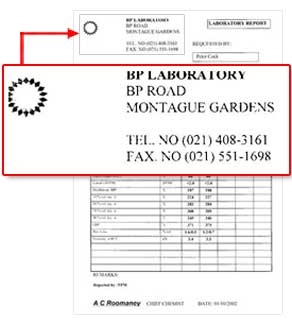 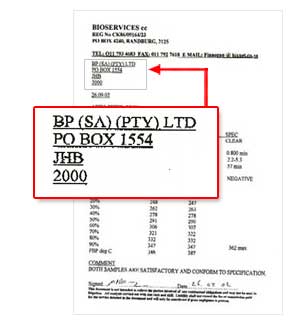
 iFleet
fuel catalyst improves burn, fuel efficiency, emissions, produces
less carbon and less heat build up. Fuel catalyst unique Fuel Additive
acts as a Fuel Injector Cleaner, increases fuel and diesel Lubricity
which prevents damage. Additive reduces carbon build up on inlet
valves due to improved burn. Fuel catalyst additive not only prevents
piston damage due to unburnt fuel, but also acts as a Fuel Saver.
Poorly atomized fuel results in poor burning, which in turn leads
to piston burn. Improves the injector spray and burn characteristic
of the fuel thereby saving fuel and preventing piston burn. During
the burning phase less carbon is produced, a growing problem with
modern engines. iFleet
fuel catalyst improves burn, fuel efficiency, emissions, produces
less carbon and less heat build up. Fuel catalyst unique Fuel Additive
acts as a Fuel Injector Cleaner, increases fuel and diesel Lubricity
which prevents damage. Additive reduces carbon build up on inlet
valves due to improved burn. Fuel catalyst additive not only prevents
piston damage due to unburnt fuel, but also acts as a Fuel Saver.
Poorly atomized fuel results in poor burning, which in turn leads
to piston burn. Improves the injector spray and burn characteristic
of the fuel thereby saving fuel and preventing piston burn. During
the burning phase less carbon is produced, a growing problem with
modern engines.
- Organic Catalyst : made directly from pharmaceutical hydrocarbon
oils, which is why iFleet fuel catalyst is the most natural composition
to interact with fuel (diesel, petrol, paraffin) without any negative
composition changes to fuel as it is from the same source, a barrel
of crude oil.
- Non-volatile, 100 % stable
- Neutral pH balanced -7 pH, neither acidic or alkaline.
- Flash Point unchanged, if any product changes the flash point,
it should rings alarm bells.
- No cetane number modification, these lead to pre-ignition in
combustion chamber.
- Material increase in lubricity, one can never has too much lubricity
as paraffin, water, heat and contamination all lower lubricity.
- Improve Cloud Point, retard fuel gelation.
- Inhibit corrosion.
- Improve filtration due to opening of wax structure.
The following substances should be avoided, are
harmful and should not be added to fuel in mass volume. Oil companies
may use small quantities or some countries extensively modify engines
to accommodate the negative aspects directly related to these elements.
No detergents, surfactants, aromatics, metals,
nitrogen, hydrogen, methanol, ethanol or any alcohol, octane-enhancing,
emulsifier bases or cetane number boosting should be used.
May have attractive short-term benefits but have severe long-term
consequences.
Test for optimal package with short and long-term benefits:
- Fuel saving should not be the main criteria for selection of
an aftermarket additive.
- Lubricity increase and carbon "soot" reduction is
just as vital as this affects the engine wear curve that provides
long-term improved efficiency and influence engine economics.
Efficiency and safety achieved with a total cost reduction
- Lubricity HFFR tested: 42-48% increase on 1:500 ratios.
- Materially less carbon during combustion.
- Fuel saving 5-7%.
- Decreases engine wear of components -extend engine
efficiency curve.
- Prevents certain engine failures -lubricity and carbon
related.
- Improves toxic emissions.
- Improves biodiesel.
Over a period of time these benefits become apparent
to our diverse client base and years of research on South African
fuel and conditions - on a scientific test basis all benefits are
observed. It is important to note that there is a cross pollination
between the different benefits and the impact this has on engine
life efficiency cycles.
Composition of the
Product
Organic Fuel catalyst made from Oil Barrel (94%) with the base product
being pharmaceutical oils, containing no metals, solvents or harmful
chemicals. The fiscal composition of the product is of such nature
that it is totally impossible to harm any engine - as the numerous
Original Equipment Manufacturer approvals testify. pH balanced and
safe to handle. Storage and shipping do not present a problem due
to its composition and high flash point.
How it works
iFleet fuel catalyst additive is capable of opening up the structure
of the fuel by the incorporation of a long unbranched hydrocarbon.
This hydrocarbon is capable of interfacing with the normal carbon
chain of the fuel and opening the structure. This allows the fuel
to oxidize much easier, thereby allowing a more complete burn. A
material lubricity increase extends and protects fuel injector and
pump life.
Less carbon formation due to improved fuel burn
during the combution process ,this visable reduction of carbon in
the compustion chaimber, verify improved effiecency were achieved
The company HSA managenent (a member of Transnet
subsidery Viamax ,responsible for procuring Transnet's diesel) has
performed various tests on the fuel catalyst: from fuel compatibility,
lubricity, viscosity , corrosion, distillation,oxidation stability,carbon
residue, flash point and density.
Tests were performed at oil companies, independent labratories
and at the most advanced testing facility in South Africa, namely
Eurotype -SABS.
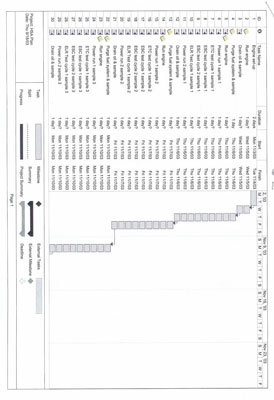 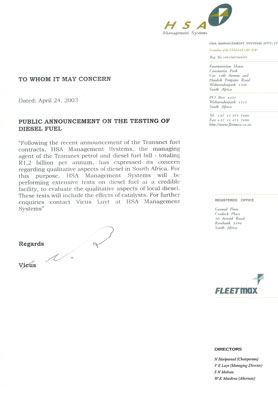
| Improved toxic emissions
as tested at Eurotype - SABS |
 |
Tested Using
Euro 3
Tested on Cycles ETC, ELR & ESC
Improved All Toxic Emissions NOX's, PM, CO, CO2, HC
Improved Smoke & Smoke Opacity Laser Test Euro3 |
| Fuel Efficiency Eurotype - SABS tested on
measuring unit PLU 121-300 |
 |
Fuel saving % dependable
on various factors:
Engine Manufacture and Model
Variable to Application
Variable to Age & Maintenance
Savings are Material even in New Euro 3 |
Results on tests performed by HSA at Eurotype at a direct cost
in exess of R1.3 million on the effect the catalyst had on all sources
of South African diesel ( synthetic ,gas and crude base)
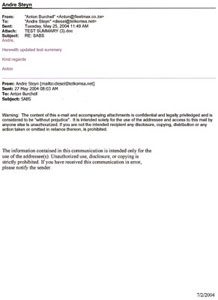 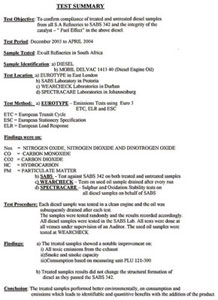
Official conclusion " The treated samples performed better
environmentally, on consumption and emissions which leads to identifiable
and quantitive benefits with the addition of the product"
Oem warranties
Click to view OEM Warranties letters
Articles |
|
| All above articles are unsolicited and
not paid for by iFleet |
 The
product provides an optimum, uniform fuel blend and open wax structure,
which promotes more complete fuel combustion with reduced toxic
emissions and increased lubrication with engine longevity. The
product provides an optimum, uniform fuel blend and open wax structure,
which promotes more complete fuel combustion with reduced toxic
emissions and increased lubrication with engine longevity.
 Lean and Green - Patric Swan - Road Ahead NEW Lean and Green - Patric Swan - Road Ahead NEW
 Chevron
Texaco - Technical Review on fuels Chevron
Texaco - Technical Review on fuels
|









 iFleet
fuel catalyst improves burn, fuel efficiency, emissions, produces
less carbon and less heat build up. Fuel catalyst unique Fuel Additive
acts as a Fuel Injector Cleaner, increases fuel and diesel Lubricity
which prevents damage. Additive reduces carbon build up on inlet
valves due to improved burn. Fuel catalyst additive not only prevents
piston damage due to unburnt fuel, but also acts as a Fuel Saver.
Poorly atomized fuel results in poor burning, which in turn leads
to piston burn. Improves the injector spray and burn characteristic
of the fuel thereby saving fuel and preventing piston burn. During
the burning phase less carbon is produced, a growing problem with
modern engines.
iFleet
fuel catalyst improves burn, fuel efficiency, emissions, produces
less carbon and less heat build up. Fuel catalyst unique Fuel Additive
acts as a Fuel Injector Cleaner, increases fuel and diesel Lubricity
which prevents damage. Additive reduces carbon build up on inlet
valves due to improved burn. Fuel catalyst additive not only prevents
piston damage due to unburnt fuel, but also acts as a Fuel Saver.
Poorly atomized fuel results in poor burning, which in turn leads
to piston burn. Improves the injector spray and burn characteristic
of the fuel thereby saving fuel and preventing piston burn. During
the burning phase less carbon is produced, a growing problem with
modern engines.










